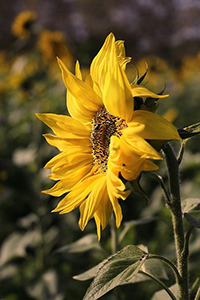Table of Contents
When the beautiful sunflower plant came to Europe from Central America in the early 16th century, it was used as an ornamental plant in gardens and parks due to the popular belief that it follows the sun’s movements.

Until the 19th century, scientists did not discover its excellent nutritional and medicinal properties. However, the ancient Mexican natives already consumed toasted sunflower seeds as food.
Healing Properties and Indications
The sunflower flowers contain a flavonoid glycoside (checimetrine) in lower amounts, in addition to histidine and other substances. In Mexico, both the flowers and the young stems are used as balsam and expectorant to fight bronchial catarrhs and respiratory afflictions.
Sunflower seeds produce a very nutritional oil rich in unsaturated fatty acids (especially linoleic acid) and vitamins A, B, and E. Sunflower oil is recommended for arteriosclerosis, to decrease cholesterol in the blood, diabetes, liver afflictions, and certain skin afflictions (eczema and furuncles).
Sunflower Plant Scientific Facts


- French: Tournesol.
- Spanish: Girasol.
- Environment: Native to the subtropical regions of America, it has spread and farmed worldwide.
- Description: The annual plant of the Compositae family grows up to two meters high. Its large flower disc is a chapter that consists of many tiny flowers.
- Parts of the plant used medicinally: The flowers, young stems, and the seeds.
How to use Sunflower
- Infusion with 100g of flowers and young stems per liter of water. Drink three or four cups daily.
- Oil of the seeds as a dietetic complement.
Frequently Asked Question
I know sunflower plant seeds are good for me, but what are the specific nutrients and compounds they provide?
Sunflower seeds are nutrition powerhouses! Here’s a breakdown of crucial nutrients in a 1-ounce (28-gram) serving of dry-roasted kernels:
1. Vitamin E: Powerful antioxidant for cell protection (about 82% of daily value)
2. Copper: Supports healthy blood vessels, bones, and nerves (25% of daily value)
3. Selenium: Important antioxidant, aids thyroid function (33% of daily value)
4. Magnesium: Benefits bone health and blood sugar control (23% of daily value)
5. Zinc: Crucial for immunity and wound healing (10% of daily value)
6. Phytosterols: Plant compounds that may help lower cholesterol
How do the health benefits of sunflower plant oil compare to other cooking oils?
The type of sunflower oil matters:
1. High-oleic sunflower oil: Rich in monounsaturated fats, making it heart-healthy and suitable for 2. high-temperature cooking.
3. Mid-oleic sunflower oil: A good mix of mono- and polyunsaturated fats, versatile for cooking.
4. Standard (Linoleic) sunflower oil: High in polyunsaturated fats. It is less stable for cooking but still offers benefits.
Always choose refined sunflower oil, as the unrefined version is less heat-stable.
Can consuming sunflower plant seeds aid in weight management?
Potentially, yes! Sunflower seeds’ fiber and healthy fats increase satiety (feeling full). Studies suggest including them in a balanced diet might support weight loss efforts. Remember, portion control is still crucial as they are calorie-dense.
Are there studies supporting the use of sunflower plant seeds for lowering cholesterol?
Yes! Research indicates that including sunflower seeds in the diet may modestly reduce LDL (“bad”) cholesterol, thanks to their fiber and phytosterol content.
Does the sunflower plant have applications beyond its seeds and oil?
Absolutely!
1. Sunflower Lecithin is used as an emulsifier in foods and supplements and has potential cognitive benefits.
2. Sunflower Sprouts: Provide a concentrated dose of vitamins and minerals.
3. Sunflower Extracts: Parts of the plant have potential anti-inflammatory and antioxidant uses that are being explored.
What potential does sunflower plant seed protein hold?
Sunflower seed protein is a promising plant-based source, especially for those with allergies. It contains essential amino acids and offers potential for muscle-building and satiety.
Are there heart health benefits associated with sunflower plant seeds?
Yes! Studies link sunflower seed consumption with:
1. Lower blood pressure (thanks to magnesium, potassium, and arginine content)
2. Reduced inflammation (due to antioxidants)
3. Improved cholesterol profile (due to fiber and healthy fats)
Can sunflower plant seeds help manage blood sugar levels?
Evidence suggests they may play a role. The fiber in sunflower seeds can slow down sugar absorption, and their magnesium content supports insulin sensitivity. More studies are needed to understand their effects fully.
Are there any safety concerns with consuming sunflower parts?
Generally, sunflower seeds and oil are safe for most individuals. However:
1. Allergies: Some people may be allergic to sunflower seeds or pollen.
2. Calorie Intake: Mindful consumption is needed, especially for weight management, as they are calorie-dense.
3. Medication interactions: Sunflower seeds might interact with some medications, so consult your doctor if you have concerns.
Where can I find reliable sources for further research on sunflower health benefits?
Trustworthy sources include:
Scientific Journals: PubMed https://pubmed.ncbi.nlm.nih.gov/
Google Scholar https://scholar.google.com/
National Institutes of Health (NIH): https://www.nih.gov/
Reputable Health Websites: Mayo Clinic https://www.mayoclinic.org/
Cleveland Clinic https://my.clevelandclinic.org/
DISCLAIMER: All content on this website is presented solely for educational and informational objectives. Do not rely on the information provided as a replacement for advice, diagnosis, or treatment from a qualified medical expert. If you are pregnant, nursing, or have any preexisting medical concerns, talk to your doctor before using any herbal or natural medicines.
REFERENCES
- George D. Pamplona-Roger, M.D. “Encyclopedia of Medicinal Plants.” George D. Pamplona-Roger, M.D. Encyclopedia of Medicinal Plants. Ed. Francesc X. Gelabert. vols. 1 San Fernando de Henares: Editorial Safeliz, 2000. 236. Print. [sunflower plant]
- USDA FoodData Central https://fdc.nal.usda.gov/
- National Institutes of Health (NIH) https://ods.od.nih.gov/
